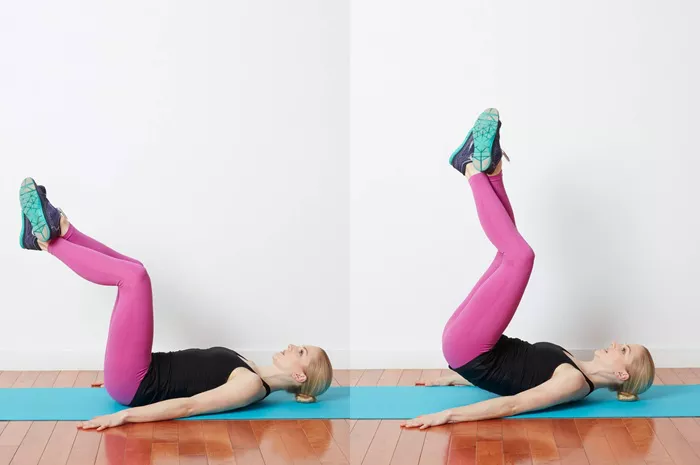Reverse crunches are a popular abdominal exercise. They are used to target the lower part of the rectus abdominis muscle. This muscle is commonly known as the “six-pack” muscle. Unlike traditional crunches, reverse crunches involve lifting the hips instead of the shoulders. This movement makes it ideal for working the lower abs.
Many fitness experts recommend reverse crunches. They are simple and effective. They do not require equipment. You can do them almost anywhere. People of different fitness levels can perform them safely. Proper form is very important. It ensures that the right muscles are engaged. It also helps prevent injury.
Muscles Worked in Reverse Crunches
Reverse crunches mainly target the lower abdominals. However, they also engage several supporting muscles:
- Rectus abdominis (lower portion)
- Transverse abdominis
- Obliques (stabilizing role)
- Hip flexors (minimally)
Because of this, reverse crunches are great for developing core strength. A strong core improves balance and posture. It also supports overall body stability.
Step-by-Step: How to Perform Reverse Crunches
Follow these steps to do reverse crunches correctly:
- Lie on your back. Keep your arms by your sides. Palms should face down.
- Bend your knees at 90 degrees. Lift your feet off the ground.
- Tighten your core. Press your lower back into the floor.
- Slowly lift your hips off the ground. Use your abdominal muscles. Do not swing your legs.
- Hold the position at the top. Pause briefly.
- Lower your hips slowly back to the floor.
- Repeat for 10–15 repetitions per set.
Common Mistakes to Avoid
Even though reverse crunches are simple, mistakes can reduce their effectiveness:
- Using momentum instead of muscle
- Pulling with the legs instead of engaging the abs
- Not keeping the core tight throughout the movement
- Overarching the lower back
Make sure to move slowly and with control. Engage your abs fully. Avoid swinging your legs or using your arms for support.
Benefits of Reverse Crunches
Reverse crunches offer many benefits:
- Target the lower abs effectively
- Improve core strength and stability
- Enhance posture and balance
- Help reduce the risk of lower back pain
- Can be done without equipment
These benefits make reverse crunches suitable for various fitness goals. They are also a good addition to Cardio Workouts and full-body routines.
How to Add Reverse Crunches to Your Routine
Reverse crunches can be included in your workout plan in many ways. Here are a few suggestions:
- As part of your warm-up or cool-down
- With other core exercises like planks or leg raises
- During Anaerobic Training circuits
Begin with 2–3 sets of 10–15 reps. Gradually increase the number of reps or sets as your strength improves.
Reverse Crunches vs. Traditional Crunches
Many people wonder about the difference between reverse crunches and traditional crunches. Traditional crunches lift the shoulders off the floor. They mostly target the upper abs. Reverse crunches lift the hips and legs. They focus more on the lower abs.
Both exercises are useful. However, reverse crunches may be easier on the neck. They are a good option for people with neck or upper back issues.
Who Should Do Reverse Crunches?
Reverse crunches are suitable for:
- Beginners trying to strengthen their core
- Athletes looking for functional strength
- Older adults needing a low-impact ab exercise
- Anyone who wants to balance upper and lower abdominal work
They are also great for Anaerobic Exercise At Home routines, making them accessible and practical.
Progressions and Variations
Once you master the basic reverse crunch, try these variations:
- Weighted Reverse Crunch: Hold a small dumbbell between your feet.
- Incline Reverse Crunch: Perform the move on a decline bench.
- Reverse Crunch with Stability Ball: Hold a stability ball between your legs.
These variations can increase intensity. They challenge your muscles more. Always maintain good form.
Combining Reverse Crunches with Other Workouts
To see results, combine reverse crunches with full-body workouts. Include cardio and resistance training. Some examples include:
- Cardio Exercises for fat burning
- Squats and lunges for lower body strength
- Push-ups and planks for upper body and core
This approach improves overall fitness. It helps tone the entire body.
Reverse Crunches for Weight Loss
Reverse crunches alone do not cause weight loss. However, they can be part of a larger plan. Combine them with healthy eating and regular exercise. Focus on full-body fat loss. This helps your abs become more visible.
Reverse Crunches and Safety
Reverse crunches are safe when done correctly. Follow these tips to avoid injury:
- Use a yoga mat or padded surface
- Do not force your hips too high
- Keep movements slow and controlled
- Stop if you feel sharp pain or discomfort
Tips to Get the Most Out of Reverse Crunches
- Exhale as you lift your hips
- Inhale as you lower them
- Keep your gaze upward
- Do not arch your back
- Engage your core at all times
Consistency is key. Add reverse crunches to your workout plan. Stay patient and track your progress.
Conclusion
Reverse crunches are one of the best core exercises. They target the lower abs. They are safe, simple, and do not require equipment. They are excellent for both beginners and advanced fitness enthusiasts.
Include reverse crunches in your routine today. You will build core strength. You will improve balance and posture. You will move closer to your fitness goals.

